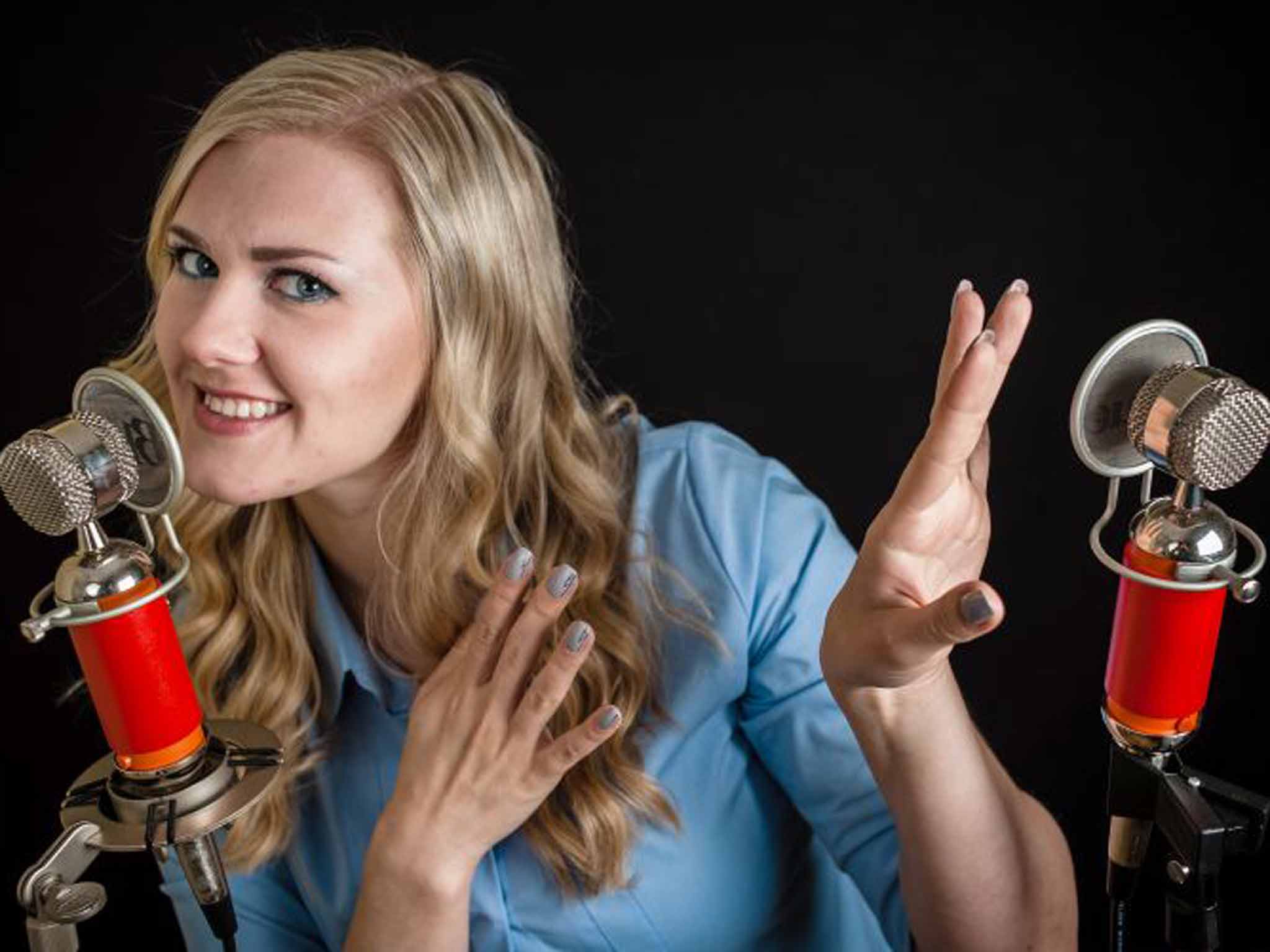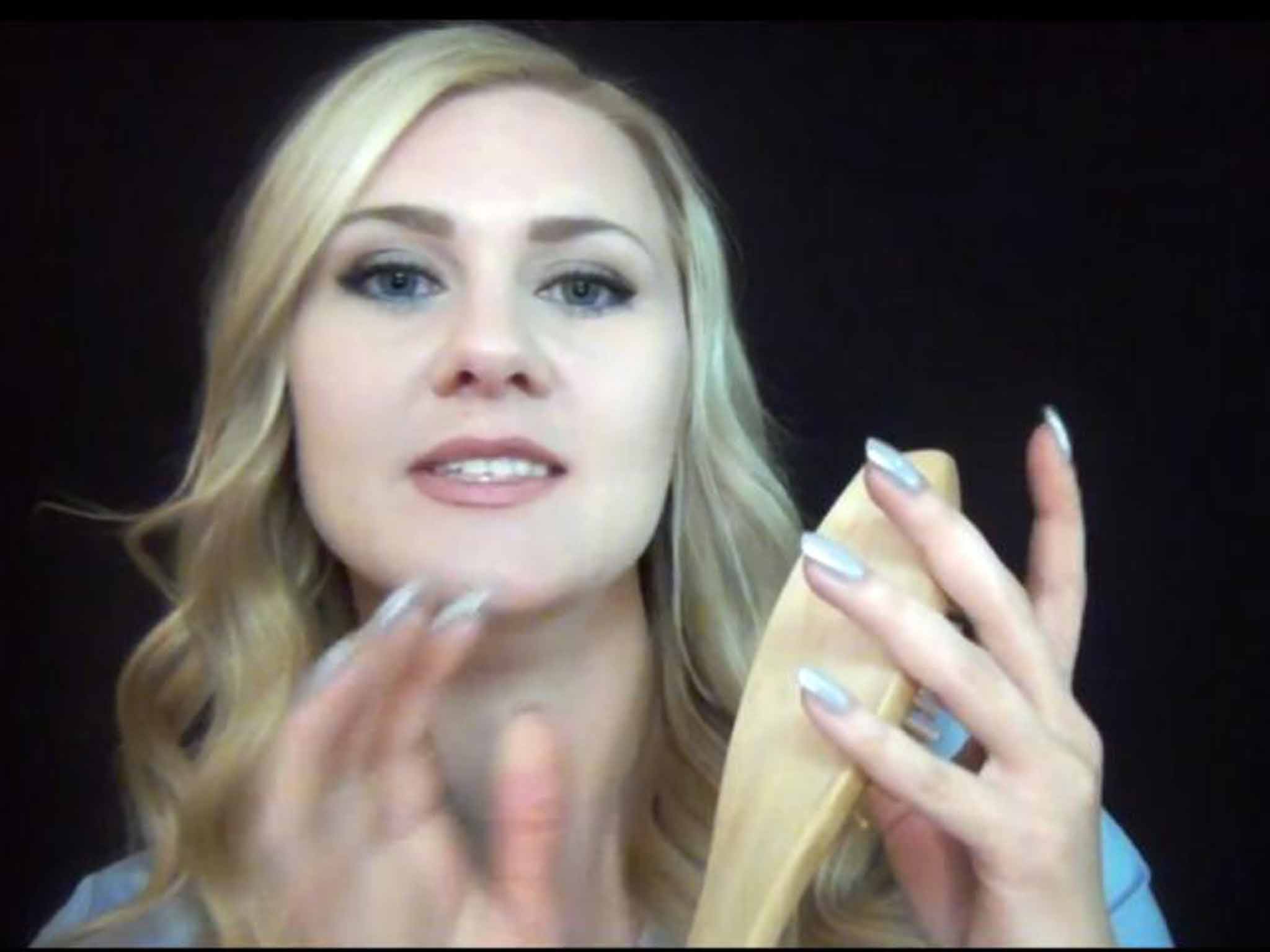GentleWhispering and ASMR: The voice that triggers euphoria and seven million YouTube views
Caitlin Gibson meets the Russian star of the ASMR phenomenon

The pretty blonde woman is plucking at the bristles of a hairbrush with gold-manicured fingertips, tapping her nails softly against the wooden handle as she holds it close to a microphone. Bathed in soft lighting, she smiles knowingly into the camera, as if sharing a secret.
"The tapping sounds remind me of the sound of the rain," she whispers. This is Maria, a 28-year-old Russian expat who lives in the US, starring in a YouTube video that has been viewed more than seven million times. Maria's devotees return again and again to listen to her as she assumes simulated roles – librarian, hairstylist, masseuse – and performs simple motions: folding towels, blowing smoke from an incense burner, flipping through a magazine.
It might sound like a bafflingly bizarre way to spend time on the internet. But for Maria's viewers, her voice and movements hold a certain magic: they can instill tranquillity, overcome insomnia – and induce a mysterious physical sensation known as autonomous sensory meridian response, or ASMR, wherein the body is flooded with waves of euphoric tingles. "It's like showers of sparkles," Maria tells me. "It's like warm sand being poured all over you, trickling over your head and down into your shoulders. It's like goosebumps on your brain."
Maria – she asked that her last name be withheld for safety reasons; her videos have sometimes attracted unwanted attention – experiences ASMR, and her YouTube channel, GentleWhispering, melds her personal tingle-triggers with others suggested by her fans. The resulting videos have drawn more than 87 million views, making Maria the premier celebrity of a controversial but increasingly recognised phenomenon.
But she says that she's not after exposure or money. Videos by other "ASMRtists" helped her through a period of depression, and now she wants to pay them back. "Little taps and crinkles, or the way certain thicker pages create the most amazing sound when they turn – many times we miss that. There are these beautiful little things that we don't pay attention to."
That's one way to explain why someone would watch a 20-minute video with no real plot, no denouement, no emotional complexity. On their face, the videos are stiflingly boring. But millions are riveted.

When she first felt it, she had no idea what it was. In school in Russia, Maria and her friends would sometimes tickle each other gently, running their fingers over the skin of their forearms. For Maria, the experience was transcendent, sending a cascade of goosebumps over her head and down her back: "I would be left in a zombie-like state. I would just be so relaxed."
She soon discovered other triggers. A teacher who whispered instructions while turning the pages of a textbook left her mesmerised. So did the crinkle of paper, a hairbrush against her scalp, soft tapping, murmured sibilance.
In 2009, three years after moving to the United States, Maria struggled with depression as she went through a divorce. While searching for relaxation videos to help her sleep one night, she clicked a suggested link, titled simply "whisper". "And as soon as I heard the lady's voice, I just got showered with tingles," Maria says. "It was so great."
She saw that dozens of other viewers had left comments describing a similar reaction. That's when she realised she wasn't alone. So whenever she felt stressed by her administrative job at a medical company, she watched a "whisper" video to calm down. And when she spoke in gentle tones, she realised that she could provide the same feeling for others.
She noticed that some of her employer's clients often asked her to show them product catalogues, although they rarely bought anything. "They would just keep asking me questions and I would keep flipping pages, and they would just zone out and stare at me," she says.
She made her first ASMR video in February 2011, filming herself as she leafed through a journal and played with seashells. The video logged two views in a month. A few months later, she tried again; this time, there were a few encouraging comments. She kept at it, and by the end of the year, she had 30,000 subscribers. Nearly three years later, she has more than 300,000.
She has invested in her craft, upgrading to top-notch binaural microphones that carry every exhale into a listener's ears as if Maria is standing beside them. Her videos, like most ASMR recordings, are undeniably intimate. But the intended response – although often described as "brain orgasms" – is not sexual, ASMR enthusiasts insist. (Unsurprisingly, a few of the online comments insist otherwise.)
Maria isn't the only ASMRtist with an impressive fan base. Her YouTube page offers a lengthy list of other recommended vloggers whom she considers friends rather than competitors. Variety, she says, is necessary to maintain one's sensitivity to ASMR.
"The more people who create the content, the less immunity there will be for everyone," she says. "We want you to try other videos so you can come back to us. So it's more of a partnership between all of us."
But it's still a business, particularly for ASMRtists who hold to a strict programming schedule, solicit donations or offer one-on-one Skype sessions for a fee. Maria declines to specify her income but says that she holds a part-time administrative job and doesn't earn enough from online ads to make a living off her videos alone – mainly because she doesn't want her vlogging to become an obligatory burden. She'll post a new video once per week or once per month, depending on how busy she is.
ASMR videos are similar to those magic eye 3D images: If you experience the intended effect, the sense of depth can be dazzling. If you don't, it's like staring at an uninspired Jackson Pollock knock-off. So the ASMR community has understandably drawn plenty of rolled eyes from those for whom a hairbrush is just a hairbrush.
But the phenomenon has nonetheless burst into the mainstream, thanks to mounting media coverage and high-profile references on American television. This year, dance DJ Deadmau5 released a track titled "Terrors in My Head" that samples Maria's recordings: "Good morning to you," drones a soothing, computerised version of Maria's voice, as if waking interstellar travellers from cryogenic sleep.
Meanwhile, tens of thousands of commenters inundate blogs, YouTube videos, Facebook and Reddit forums with their ASMR experiences. Scroll through these lists, and the array of triggers is largely consistent: classical music, haircuts and film trailers. Still sceptical? Craig Richard, a professor and researcher at the Shenandoah University School of Pharmacy in Virginia, and founder of a blog called ASMR University, says that's just fine. "If you don't experience it, and there's no published research, I think it's appropriate to be sceptical," he says. "I don't know if I would believe it if I didn't experience it myself."
In a 2012 blog post, Steven Novella, an academic clinical neurologist at Yale University School of Medicine, compared ASMR to migraine headaches – "We know they exist as a syndrome primarily because many different people report the same constellation of symptoms and natural history," he wrote – and theorized that ASMR could even be a type of "pleasurable" seizure.
Maria says that she hears from subscribers, including doctors and psychologists, who are excited by the ASMR research. But mostly, she gets thank-you notes – from people with anxiety or sleep disorders, from overwhelmed students struggling through exams week and from military veterans who tell her that her videos offer a sense of calm they can't find elsewhere.
But maybe it's not so surprising. Consider Maria's most-viewed video, every element in the shot meticulously chosen: the subtly patterned wallpaper behind her, the dim lighting, her muted sweater and – especially – her words. "I would like to protect you, to comfort you," she murmurs. "To help you relax and forget about your trouble, whatever it is."
She smiles and leans close, tracing her fingers over the camera lens as if caressing a face. "Don't worry about anything," she whispers. "Everything is going to be all right."
© Washington Post
Join our commenting forum
Join thought-provoking conversations, follow other Independent readers and see their replies
Comments